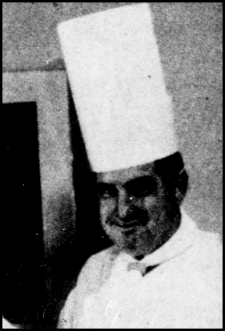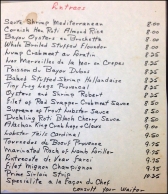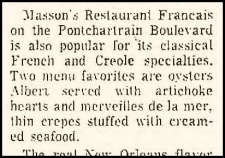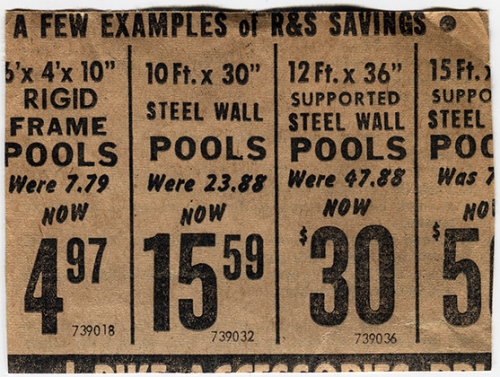It really only looks like a Robert if you squint.
|
Chef Robert Finley of Masson’s Restaurant Français. Detail from a photo in the March 3, 1974 Parade magazine insert; this edition from the The Bakersfield Californian. |
Ordinarily speaking, a dish that’s described as Robert would be some form of seafood served in a sort of étoufée-inspired white sauce over rice or pasta. Because that’s how Robert Finley, a longtime chef at Masson’s Restaurant Français, did it. That’s him, over to the left.
Finley is a Scottish name, but what little discussion of Finley there is online seems to agree that he was a creole chef. If it seems odd that a Scottish man would be in charge of making more or less French cuisine — you can debate whether Masson’s served creole food with a veneer of French Provincial, or French food with a splash of local heat — it was certainly less odd in New Orleans, where the more famous Brennan’s serves French food under the name of its Irish-American founder.
Brennan’s, of course, had an easier time becoming famous, because it is in the French Quarter, where tourist traffic forms a reliable clientele who return home with stories that increase the fame of the businesses there. But Masson’s was in the 10th Ward, about seven miles away from the Café du Monde and the bro-tanked, hurricane-swilling tourism of those parts of the 4th and 5th Ward touching the Mississippi river.
Here’s a rough diagram:
|
Graphic incorporates Augustus Mitchell map of New Orleans, c. 1870, from WikiMedia Commons; Beignets at Café du Monde, by vxla, on Flickr (CC license); and detail of Masson’s menu.
|
The logo from Masson’s menu above is pinching right about at 7200 Pontchartrain Boulevard. In 1916, French-born Albert Dubos, who had worked previously as a waiter and bartender, opened a restaurant there called the Bungalow. While that term typically connotes a small cottage with a large porch in modern parlance, it had something of an exotic sound around the dawn of the 20th century, when British officers in India would use the term to describe their sprawling estates.
That said, Dubos’ Bungalow had more in common with the modern connotation than the excesses of the British Raj. It was a roadhouse, relying primarily on traffic from locals heading to and from the lake (the Southern Yacht Club was around; the New Orleans Yacht Club that occupies the nearby dock didn’t form until 1946).
Meanwhile, Dubos’ daughter, Martha, married a Third Ward pharmacist named Ernest Masson.
When Martha inherited the restaurant in 1946, the couple changed the name slightly to Masson’s Beach House. When the couple finally decided they wanted to make a go of this as a family enterprise, they sent their sons to France to learn: Ernie (that is, Ernest junior) studied cooking at the Cordon Bleu and Albert studied wine. (This is also when Robert Finley–remember him?–started to show up on the menus.)
Here’s a menu that came up for auction a while back:
Along with “Oysters and Shrimp Robert,” you should notice the “Baked Oysters Albert,” named after Albert Masson. While I haven’t found a definitive recipe, the general description I’ve seen (and correct me if you have a better one, please!) is that they were baked on the half shell with artichoke hearts, crabmeat, bread crumbs and parmesan.
The 1960s brought the JFK White House, which meant a sudden fascination with French food, particularly what the public perceived as “gourmet” French food. (There just aren’t enough words or space in this world to unpack why the whole fixation with things being gourmet never made sense and will never make sense. The short version is that the word indicates a cultural ideal. Culture is a human thing. Food has no opinion of any kind, at least not once it’s cooked; and your cultural hangups about the degree of refinement necessary to eat one thing or another is a little play going on entirely in your head. If you have so little respect for your food that you feel the need to create an imaginary class of “elite” food to justify treating your food with respect, then you need you re-evaluate your relationship to gastronomy.)
Nevertheless, the brothers Masson realized their marketing could improve to match this trend, and so they dropped the Beach House to become just Masson’s Restaurant Français. From a later menu:
Notice that one of the items added to the menu, in the third image, is “Poisson du Bayou Dubos” — a mention of the Masson brothers’ grandfather and the founder of the original Bungalow.
Another item on the menu got a brief description in the January 20, 1968 edition of The Cumberland (Maryland) News:
|
Masson’s Restaurant Francais on the Pontchartrain Boulevard is also popular for its classical French and Creole specialties. Two menu favorites are oysters Albert served with artichoke hearts and merveilles de la mer, thin crepes stuffed with creamed seafood.
|
Masson’s was closed and re-opened in the 1990s by the fourth generation as Debbie Masson’s, but is now entirely gone, with new construction showing up when you peek at the site on Google Maps. Still, Oysters Albert and Shrimp Robert will pop up from time to time in other places or cookbooks. Authentic French cooking? Well, it depends on how you look at it. Authentic creole, anyway.
Here’s the back of our clipped recipe, by the way:
From a box sold in Lyndhurst, New Jersey.
Crab Meat Robert
You will need:
Crab meat, shredded
Mayonnaise
Chives, chopped fine
Hollandaise sauce
Paprika
Now:
- Mix the chives into the mayonnaise. Use a generous amount of chives.
- Stir in the crabmeat. The crab should be well coated.
- Pack this mixture into the large halves of clam shells for a small hors d’oeuvre, or into the casserole for larger portions.
- Spread hollandaise sauce over the mixture. Mask it well.
- Dust very lightly with paprika.
- Place in 375-degree oven and bake until lightly browned and bubbly. Serve hot.
With this: If served as an hors d’oeuvre, a dry sherry will go well–if expanded to a main dish, serve a dry white wine.












